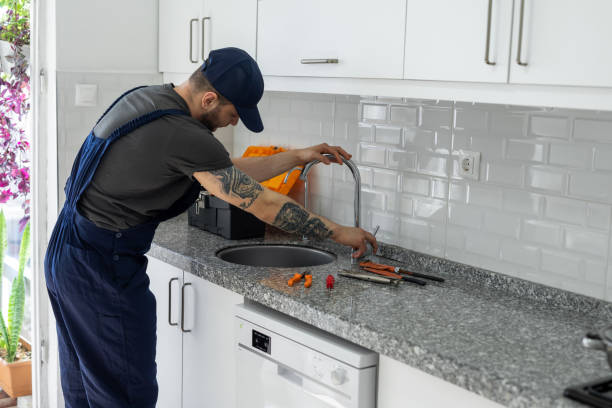Picture this: you walk into your kitchen or bathroom, turn on the faucet, and instead of a smooth stream of water, you’re greeted with an unexpected spray and splutter. Your faucet seems to have developed a mind of its own, and it’s making a mess of things. Don’t panic just yet – you’re not alone in facing this plumbing predicament. In this comprehensive guide, we’ll delve into the reasons behind your faucet’s unruly behavior, explore troubleshooting steps to identify the issue, and equip you with the knowledge to resolve it efficiently, whether it’s fixing the problem or considering a replace kitchen faucet solution. So, let’s roll up our sleeves and tackle the challenge head-on!
Understanding the Symptoms
Before diving into solutions, it’s crucial to understand the symptoms of a faucet gone rogue. Here are some common signs to watch out for:
- Erratic Water Flow: Instead of a steady stream, the water spurts out inconsistently, often accompanied by air bubbles.
- Spraying or Spluttering: The faucet emits water in unpredictable directions, resulting in splashing and spraying beyond the sink basin.
- Strange Noises: You might hear gurgling or hissing sounds emanating from the faucet, indicating potential air or water pressure issues.
- Low Water Pressure: In some cases, the faucet may produce significantly reduced water pressure, affecting its functionality.
Now that we’ve identified the symptoms, let’s move on to diagnose the underlying causes.
Diagnosing the Issue
To effectively troubleshoot your faucet’s erratic behavior, it’s essential to pinpoint the root cause. Here are some common culprits to consider:
- Aerator Blockage: The aerator, located at the tip of the faucet, can become clogged with mineral deposits or debris over time, disrupting the flow of water.
- Loose or Worn Components: Loose fittings, worn-out seals, or damaged internal parts can lead to water leakage and irregular flow patterns.
- Water Pressure Fluctuations: Variations in water pressure within the plumbing system can manifest as erratic water flow and spluttering from the faucet.
- Air Entrapment: Air trapped in the pipes can cause water to sputter and spray when the faucet is turned on, especially after plumbing repairs or maintenance.
- Faulty Cartridge or Valve: If your faucet operates using a cartridge or valve mechanism, malfunctions or wear and tear in these components can result in erratic water flow.
By systematically examining these potential causes, you’ll be better equipped to address the issue effectively.
Troubleshooting Steps
Now that we’ve identified possible causes, let’s proceed with the troubleshooting steps:
- Inspect the Aerator: Start by unscrewing the aerator from the faucet tip and examining it for any signs of blockage. Clean the aerator thoroughly by soaking it in vinegar or using a brush to remove debris.
- Check for Loose or Worn Parts: Inspect the faucet handles, spout, and connections for any signs of looseness or wear. Tighten any loose fittings and replace worn-out seals or components as needed.
- Test Water Pressure: Use a pressure gauge to measure the water pressure at various faucets throughout your home. If pressure fluctuations are detected, consider consulting a professional plumber to assess and address the underlying issues.
- Bleed Air from the Pipes: Turn off the main water supply to your home and open all faucets to allow trapped air to escape from the plumbing system. Once the water runs smoothly, close the faucets in reverse order.
- Inspect Cartridge or Valve: If your faucet features a cartridge or valve mechanism, carefully disassemble the faucet to inspect these components for any signs of damage or malfunction. Replace any faulty parts following the manufacturer’s guidelines.
By systematically following these troubleshooting steps, you’ll be well on your way to resolving the faucet’s erratic behavior and restoring normal functionality.
Prevention and Maintenance Tips
Prevention is always better than cure when it comes to plumbing issues. Here are some preventive measures and maintenance tips to keep your faucets in top condition:
- Regular Cleaning: Periodically clean your faucet aerators and remove any accumulated debris or mineral deposits to maintain optimal water flow.
- Avoid Hard Water Buildup: Install a water softener or use vinegar solutions to prevent mineral buildup in your plumbing fixtures, including faucets.
- Address Leaks Promptly: Don’t ignore minor leaks or drips from your faucet, as they can worsen over time and lead to more significant issues. Promptly repair or replace faulty components to prevent water wastage and damage.
- Schedule Professional Inspections: Consider scheduling periodic plumbing inspections with a licensed plumber to detect and address potential issues before they escalate.
- Temperature Regulation: Avoid exposing your faucets to extreme temperatures, as this can cause damage to internal components. Insulate outdoor faucets during colder months to prevent freezing and bursting.
Conclusion:
Dealing with a faucet that spits water everywhere can be a frustrating experience, but armed with the knowledge and troubleshooting techniques outlined in this guide, you’re well-equipped to tackle the challenge effectively, with assistance from a local plumber in Katy if needed. By understanding the symptoms, diagnosing the underlying causes, and following the recommended troubleshooting steps, you can regain control over your faucet and restore it to optimal functionality. Remember, preventive maintenance and prompt repairs are key to keeping your plumbing fixtures in top condition and avoiding future headaches. So, don’t let a rogue faucet dampen your spirits – take charge and conquer the problem like a seasoned troubleshooter!



